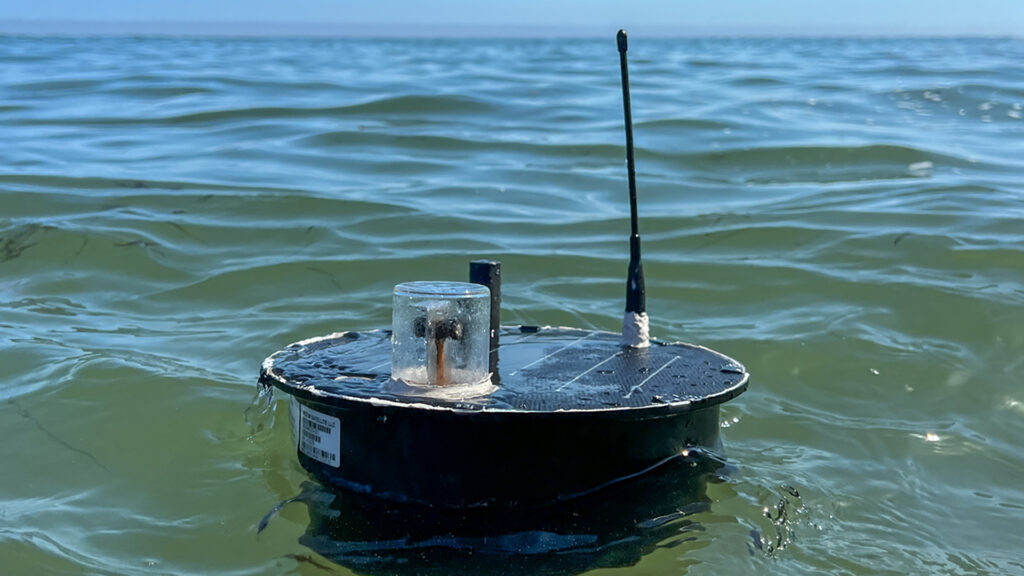
PEARL drifters pack an array of sensors into a compact autonomous device to gather data and signs of activity.
With a surface area of about 140 million square miles, the vastness of Earth’s oceans is hard to convey, but as a point of reference, consider that it would take an area nearly 50 times the landmass of the United States to plaster the oceans over. Given this immensity, most of what happens out in the oceans remains unknown.
To help civilian researchers, commercial entities, and governments understand maritime happenings, SRI researchers have created a novel kind of ocean drifter. Known as a Persistent Environmental Awareness Reporting and Location (PEARL) drifter, thousands of these devices are deployed to float far and wide, acquiring a plethora of useful data to send back to shore. By forming a sprawling coverage network, PEARL drifters can pick out proverbial needles in the oceanic haystack, enhancing numerous applications in environmental monitoring and national security.
“Oceans are mostly vast and uninteresting,” said Julie Bert, lab director for the Hardware Research and Technology Lab at SRI. “But if you have something like our drifters that can say, ‘Hey, here’s where there’s interesting activity,’ across all of the hundreds of thousands of square kilometers you’re monitoring—that’s very valuable.”
“With these drifters, you can start to fill in the gaps from a monitoring capability perspective,” added Brien Buckman, who is leading commercialization efforts for PEARL. “The ability to understand what is happening in remote areas and provide an unprecedented level of data and insight is game-changing for our customers and partners.”
Compact, sensor-loaded, and versatile
The drifters pack small, yet powerful and energy-efficient componentry into a chassis structured with corrosion-resistant material. They include a host of sensors for detecting oceanographic parameters as well as anthropogenic activity, such as ships or other types of human presence.
“We’ve been able to measure oceanographic activity with a lot of clarity, such as real-time mapping of ocean currents, and clients have said that incorporating these data can boost the accuracy of their prediction models,” said Bert. “We’ve also started to show wave spectra and wave height variation, which can help make decisions about deployment and safety.”
“We’ve started to show wave spectra and heights variation, which can help make decisions about deployment and safety.” – Julie Bert
The overall range of sensing capabilities packaged together at low cost is what sets PEARL drifters apart from other oceangoing drifter platforms that have been developed in recent years. “The biggest difference is the variety of sensors at the low price point that we’re able to achieve,” said Bert.
Much of the data the sensors gather is partially processed up-front through anomaly detection algorithms and other means of prioritizing signals of interest prior to transmitting the data to customer systems. “Because the drifters are collecting so much data, we have a lot of onboard processing that analyzes the data locally,” said Eric Cocker, a senior researcher at SRI working on software and analytics components. “The drifters do a lot of compression for transmission, so we pull out the features that customers consider valuable.”
Adding to the flexibility of the drifters, their sensing parameters can be updated post-deployment to zero in on data features. Threshold settings can be altered, for instance, as well as sampling rates. “The customer can say, ‘I want more of that data and less of that data,’ and we can do that with drifters already deployed in the middle of the ocean. This helps customers get the data and insights they want, when they need it,” said Buckman.
All the better to sense you with
The sensors cover quite the gamut of perceptual ability. For basic environmental information, there are temperature, humidity, and atmospheric pressure sensors. An onboard solar panel can measure solar radiance, important for weather and climatic modeling. An inertial measurement unit contains an accelerometer, gyroscope, and magnetometer, useful for calculating wave statistics, and other data.
Additional mission-relevant sensors can be included depending on customer needs. Options include a pair of cameras that provide a near-360-degree field of view; a microphone and a hydrophone for acoustics, software-defined radios that can detect radio frequency use, fluorescence for observing bioluminescence, a volatile organic compound sensor, and a high-sensitivity magnetometer.
The drifters have been designed with the environment in mind. For example, Bert said her group has used as little plastic as possible in the drifter architecture. To prevent the devices from washing up on beaches, little glass panels on the drifters can break, letting in air and water and sinking the device to the bottom of the ocean where their environmental impact is minimized. This feature can also be activated on command or based on preset conditions such as geolocation.
“We’ve been very conscious of device end-of-life and about making sure they don’t drift into places where the government or other customers may not want them,” said Bert.
The newest phase of PEARL
So far, two generations of drifters have been manufactured and delivered to customers, totaling 1500 and 5000 each. Most drifters were deployed as part of the Defense Advanced Research Projects Agency’s (DARPA) Ocean of Things program, which aimed to demonstrate “persistent maritime situational awareness over large ocean areas by deploying thousands of small, low-cost devices that form a distributed sensor network,” according to the program website. Major deployments have taken place in the Gulf of Mexico, “where you have these loop currents that nicely spread the drifters out,” said Bert, and into the Gulf Stream current, which disperses drifters throughout the North Atlantic.
With the DARPA program now concluded, PEARL drifters are continuing to receive significant attention—particularly from branches of the U.S. military—and a third phase of development is underway. “We’re excited to continue building relationships with government and commercial entities who have an interest in the insights that can be derived from this platform,” said Buckman.
To learn more, please visit the PEARL drifter webpage, or contact us directly.



